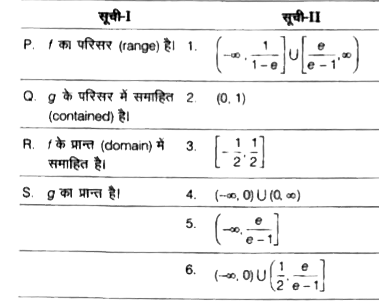एक ΔABC में सामान्य संकेतों के आधार पर दिया है कि b+c11=c+a12=a+b13 है। यदि cosAα=cosBβ=cosCγ है , तो क्रमिक त्रिक (α,β,γ) का मान है
(7,19,25)
(19,7,13)
(3,4,5)
(5,12,13)
The correct Answer is:A
Step by step video, text & image solution for एक Delta ABC में सामान्य संकेतों के आधार पर दिया है कि (b+c)/(11) = (c+a)/(12) = (a+b)/(13) है। यदि (cos A)/(alpha) = (cos B)/(beta) = (cos C)/(gamma) है , तो क्रमिक त्रिक (alpha, beta, gamma) का मान है by Maths experts to help you in doubts & scoring excellent marks in Class 12 exams.
Updated on:21/07/2023Topper's Solved these Questions
- JEE MAIN 2019BOOK - JEE Main & Advanced (Hindi Medium)CHAPTER - JEE MAIN 2019EXERCISE - 12 January Shift-I
30 Videos
- JEE MAIN 2019BOOK - JEE Main & Advanced (Hindi Medium)CHAPTER - JEE MAIN 2019EXERCISE - 12 January Shift-II
30 Videos
- JEE MAIN 2019BOOK - JEE Main & Advanced (Hindi Medium)CHAPTER - JEE MAIN 2019EXERCISE - 11 January Shift - I
30 Videos
- JEE ADVANCED सोल्वड पेपर्स 2018 BOOK - JEE Main & Advanced (Hindi Medium)CHAPTER - JEE ADVANCED सोल्वड पेपर्स 2018 EXERCISE - पेपर 2 (खण्ड 3)
4 Videos
- JEE MAIN QUESTION PAPER 2013BOOK - JEE Main & Advanced (Hindi Medium)CHAPTER - JEE MAIN QUESTION PAPER 2013EXERCISE - PART-C - गणित (MATHEMATICS)
30 Videos
Similar Questions
यदि z−αz+α(α∈R) एक शुद्ध रूप से काल्पनिक संख्या है तथा |z|=2 है तो α का एक मान है
View Solutionयदि λ के उन सभी वास्तविक मानो, जिनके लिए बिन्दुओ (−λ2,1,1),(1,−λ2,1) तथा (1,1−λ2) से होकर जाने वाला एक समतल, बिन्दु (−1,−1,1) से भी होकर जाता है, का समुच्चय S है, तो S बराबर है
View Solutionसमुच्चय {1,2,….,11} से दो पूर्णांक यादृच्छिक लिए गे हैं। दिया है कि ली गई संख्याओं का योग सम है , दोनों संख्याओं के सम होने की सप्रतिबन्ध (conditional) प्रायिकता है
View Solutionमाना की E1={x∈R:x≠1औरxx−1>0} और E2={x∈E1sin−1(loge(xx−1)} एक वास्तविक संख्या (real number) है|
(यहाँ प्रतिलोम त्रिकोणमितीय फलां (inverse trignometric function) sin−1x,[−π2,π2] में मान धारण करता है|
माना की फलन: f:E1→R,f(x)=loge(xx−1) के द्वारा परिभाषित है
और फलन f:E2→R,g(x)=sin−1lloge(xx−1) के द्वारा परिभाषित है|

दिए हुए विकल्पों में से सही विकल्प है
View Solutionदो समान्तर समतलों 2x+y+2z=8 तथा 4x+2y+4z+5=0 के बीच की दूरी है|
View SolutionDelta ABC has vertices A(a cos alpha,a sin alpha),B(a cos beta,a sin beta) and C(a cos gamma,a sin gamma) then its orthocentre is
View SolutionIf alpha,beta,gamma are the lengths of the altitudes of Delta ABC, then (cos A)/(alpha)+(cos B)/(beta)+(cos C)/(gamma)=
View SolutionIf alpha=cos alpha+i sin alpha,b=cos beta+i sin beta,c=cos gamma+i sin gamma and (b)/(c)+(c)/(a)+(a)/(b)=1 then cos(beta-gamma)+cos(gamma-alpha)+cos(alpha-beta)=
View SolutionIf origin is the orthocentre of the triangle with vertices A(cos alpha,sin alpha),B(cos beta,sin beta),C(cos gamma,sin gamma) then cos(2 alpha-beta-gamma)+cos(2 beta-gamma-alpha)+cos(2 gamma-alpha-beta)=
View SolutionGiven b+c11=c+a12=a+b13 for a ΔABC with usual notation. If cosAα=cosBβ=cosCγ then the ordered traiad, (α,β,γ) has a vlaue
View Solutionकिसी ΔABC में सिध्द कीजिये कि:
(a)sin(α+β+γ)+sin(α−β−γ)+sin(α+β−γ)+sin(α−β)+γ)=4sinαcosβcosγ
(b)cos(α+β+γ)+cos(β+γ−α)+cos(γ+α−β)+cos(α+β−γ)=4cosαcosβcosγ
View SolutionGiven b+c11=c+a12=a+b13 for a ΔABC with usual notation. If cosAα=cosBβ=cosCγ, then the ordered triad (α,β,γ) has a value:
View SolutionLet A=(cosα,sinα),B=(cosβ,sinβ),C=(cosγ,sinγ). If origin is the orthocentre of the ΔABC, then the value of ∑cos(2α−β−γ)=____________
View Solutionयदि α,βγ, समीकरण ax3+bx3+c=0 के मूल है | तो सारणिक ∣∣ ∣ ∣∣αββγγαβγγααβγααββγ∣∣ ∣ ∣∣ का मान होगा |
View SolutionIf a,b,c are vectors of equal magnitude such that (a,b)= α, (b,c)= β, (c,a)= γ, then the minimum value of cos α+cosβ+cosγ is
View Solution